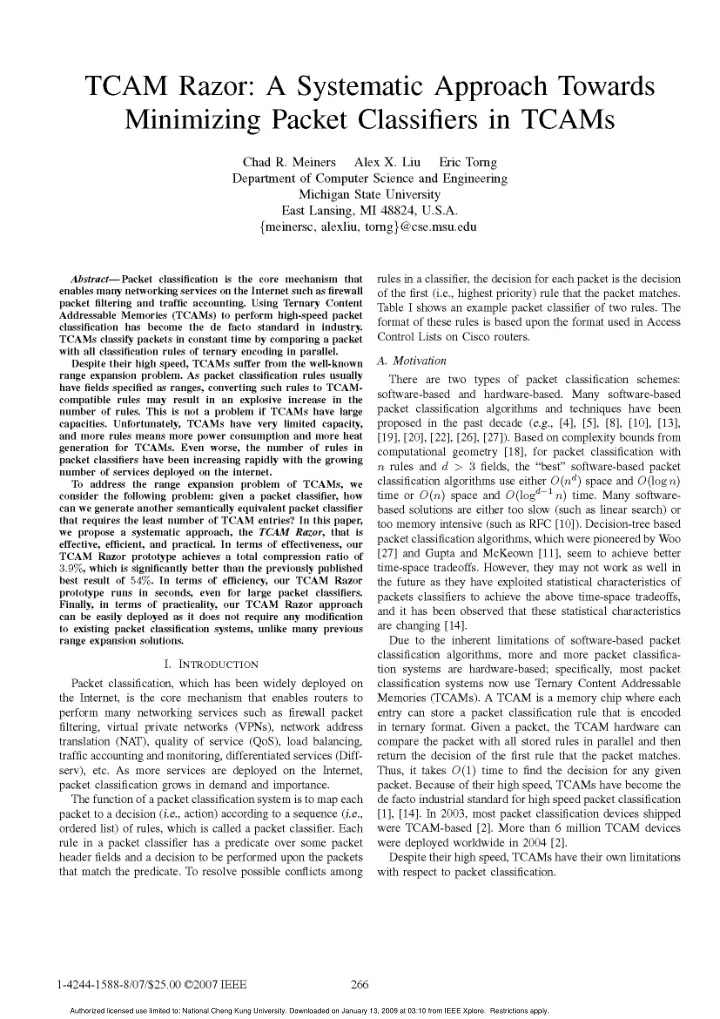

TCAM Razor: A Systematic Approach Towards Minimizing Packet Classifiers in TCAMs Chad R. Meiners Alex X. Liu Eric Tomg Department of Computer Science and Engineering Michigan State University East Lansing, MI 48824, U.S.A. {meinersc, alexliu, tomg} @cse.msu.edu rules in a classifier, the decision for each packet is the decision Abstract- Packet classification is the core mechanism that enables many networking services on the Internet such as firewall of the first (i.e., highest priority) rule that the packet matches. packet filtering and traffic accounting. Using Ternary Content Table I shows an example packet classifier of two rules. The Addressable Memories (TCAMs) to perform high-speed packet format of these rules is based upon the format used in Access classification has become the de facto standard in industry. Control Lists on Cisco routers. TCAMs classify packets in constant time by comparing a packet with all classification rules of ternary encoding in parallel. A. Motivation Despite their high speed, TCAMs suffer from the well-known range expansion problem. As packet classification rules usually There are two types of packet classification schemes: have fields specified as ranges, converting such rules to TCAM- software-based and hardware-based. Many software-based compatible rules may result in an explosive increase in the packet classification algorithms and techniques have been number of rules. This is not a problem if TCAMs have large proposed in the past decade (e.g., [4], [5], [8], [10], [13], capacities. Unfortunately, TCAMs have very limited capacity, and more rules means more power consumption and more heat [19], [20], [22], [26], [27]). Based on complexity bounds from generation for TCAMs. Even worse, the number of rules in computational geometry [18], for packet classification with packet classifiers have been increasing rapidly with the growing n rules and d > 3 fields, the "best" software-based packet number of services deployed on the internet. classification algorithms use either 0(nrd) space and 0(log n) To address the range expansion problem of TCAMs, we time or 0(n) space and 0(logd-1 n) time. Many software- consider the following problem: given a packet classifier, how can we generate another semantically equivalent packet classifier based solutions are either too slow (such as linear search) or that requires the least number of TCAM entries? In this paper, too memory intensive (such as RFC [10]). Decision-tree based we propose a systematic approach, the TCAM Razor, that is packet classification algorithms, which were pioneered by Woo effective, efficient, and practical. In terms of effectiveness, our [27] and Gupta and McKeown [11], seem to achieve better TCAM Razor prototype achieves a total compression ratio of time-space tradeoffs. However, they may not work as well in 3.9%, which is significantly better than the previously published best result of 54%. In terms of efficiency, our TCAM Razor the future as they have exploited statistical characteristics of prototype runs in seconds, even for large packet classifiers. packets classifiers to achieve the above time-space tradeoffs, Finally, in terms of practicality, our TCAM Razor approach and it has been observed that these statistical characteristics can be easily deployed as it does not require any modification are changing [14]. to existing packet classification systems, unlike many previous Due to the inherent limitations of software-based packet range expansion solutions. classification algorithms, more and more packet classifica- I. INTRODUCTION tion systems are hardware-based; specifically, most packet Packet classification, which has been widely deployed on classification systems now use Ternary Content Addressable the Internet, is the core mechanism that enables routers to Memories (TCAMs). A TCAM is a memory chip where each perform many networking services such as firewall packet entry can store a packet classification rule that is encoded filtering, virtual private networks (VPNs), network address in ternary format. Given a packet, the TCAM hardware can compare the packet with all stored rules in parallel and then translation (NAT), quality of service (QoS), load balancing, traffic accounting and monitoring, differentiated services (Diff- return the decision of the first rule that the packet matches. Thus, it takes 0(1) time to find the decision for any given serv), etc. As more services are deployed on the Internet, packet classification grows in demand and importance. packet. Because of their high speed, TCAMs have become the de facto industrial standard for high speed packet classification The function of a packet classification system is to map each packet to a decision (i.e., action) according to a sequence (i.e., [1], [14]. In 2003, most packet classification devices shipped ordered list) of rules, which is called a packet classifier. Each were TCAM-based [2]. More than 6 million TCAM devices rule in a packet classifier has a predicate over some packet were deployed worldwide in 2004 [2]. header fields and a decision to be performed upon the packets Despite their high speed, TCAMs have their own limitations that match the predicate. To resolve possible conflicts among with respect to packet classification. 1-4244-1588-8/07/$25.00 C2007 IEEE 266 Authorized licensed use limited to: National Cheng Kung University. Downloaded on January 13, 2009 at 03:10 from IEEE Xplore. Restrictions apply.
Recommend
More recommend